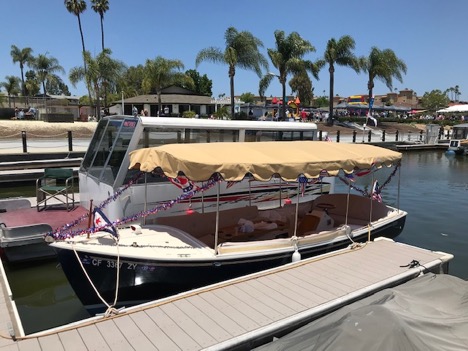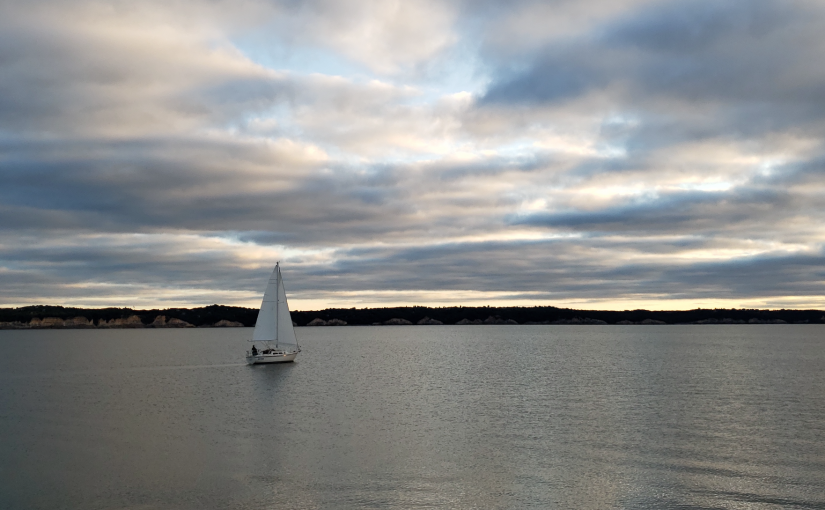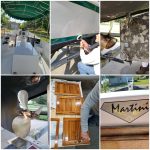Bruce Carlile is a lifelong boater. He grew up in California’s San Diego Bay Area sailing, racing and enjoying life. From participating in the Junior Sailing Program at his local yacht club to racing a variety of sailboats, including Sabots, Lasers, Hobie Cats, Star keelboats and more, to speeding along on his family’s powerboats, Bruce can’t imagine his life without a boat of some kind in it. In 2018, he obtained his late father’s Duffy boat. It was in rough shape, having been devastated by a freak November storm, but Bruce was determined to save it. With time, hard work and his Ultrafeed® Sewing Machine, he was able to restore his father’s boat to its former glory.

A Cocktail Cruiser
Bruce’s lifelong love of boats was inherited from his parents. “My parents had a place in Coronado Cays, a residential marina in the south end of San Diego Bay, and there was a dock behind the house. It was the perfect setting for a cruising boat, and my father saw one cruising by one day.” Bruce’s father asked the owner what type of boat it was and that’s how he was introduced to the Duffy boat. Soon after, he bought one for himself — first an 18-foot Duffy and then he upgraded to the 22-foot Duffy Classic.
As soon as Bruce’s father purchased the Duffy, Bruce immediately fell in love with the boat’s laid-back design. The first electric boat, a Duffy glides slowly and silently on the water and is designed for the cruising lifestyle. Nicknamed a “cocktail cruiser,” this slow-moving vessel maxes out at about 5 mph. For owners of this boat, it’s about the journey, not the destination.
Giving DIY a Try
The Duffy was a 2005 model and came with the original surrey top. It was worn out and needed to be replaced. Bruce contacted local shops inquiring about a commercially made replacement top for his father’s Duffy and was shocked by the quote. “Commercial and factory-made surrey tops were priced at about $6,000! I then started researching how to make them and came across the Sailrite website. After watching the DIY videos, I figured that I could make it myself.”

Bruce didn’t let his complete lack of sewing experience deter him from tackling the project. He purchased the Ultrafeed LSZ Sewing Machine as well as Sunbrella® fabric and binding, patterning material, zippers and all the other tools and accessories to sew a new surrey top. “Using only Sailrite materials, I successfully completed the project for less than half of the price of a commercially available Sunbrella top, even including the price of the sewing machine!”
In addition to purchasing all his supplies and sewing machine from Sailrite, he also relied heavily on Sailrite’s inventory of how-to videos and tutorials. “The DIY videos were key,” Bruce explained. “I’m a visual learner, and had it not been for those instructional videos I don’t think I could have done it. I found the Ultrafeed incredibly easy to learn how to use and I quickly became proficient at sewing with it.”

When his father passed away in 2014, the boat went to Bruce’s sister. Unfortunately, his sister’s family didn’t use the boat and from 2014 to 2018 it fell into disrepair. “In the fall of 2018, they put it up for sale and I offered to buy it,” Bruce said. However, that Thanksgiving, a catastrophic storm rolled through the San Diego area. The high winds and heavy rains did terrible damage, ripping the Duffy’s surrey top to shreds. “Winds were estimated at over 60 mph with even higher gusts,” Bruce recalled.
A Passion Project
Due to the storm’s damage and the years of neglect, just about everything needed to be fixed. Bruce was dutifully up to the task. The boat needed a new surrey top, new vinyl side curtains, new upholstery and carpeting. “The hull had oxidized badly, the boot stripe had worn away from rubbing against the dock, and the running gear was horribly corroded. So I set about restoring it, completely refurbishing every inch. I made a new surrey top (my second one) and replaced the engine belt, shaft, cutlass bearing, propeller and new bottom paint.”
“Nothing went untouched. I had to buy a used trailer and retrofit it to take the Duffy. I towed it to a storage yard, bought a portable generator to provide electricity for the power tools, and relaunched her 6 months later.”
What began as a cost-cutting measure has grown into a true passion for sewing and DIY. “It started out as a way to save money but grew into the challenge and accomplishment of making it myself. Not only that, but I also taught myself a very useful trade, especially being a boater.” Bruce and his wife also own a 21-foot Yamaha ski boat and two Yamaha WaveRunners®. “I will be making new covers for the WaveRunners this summer to prepare them for next winter.”

Duffy Sewing & Beyond
Bruce’s uses for the Ultrafeed haven’t stopped at his Duffy boat. “I’ve found myself venturing into new areas where I can utilize my sewing skills. I’ve repaired a jean jacket for my niece. I sewed a custom canvas cover for a high school basketball scorekeeper’s table. I’ve even made safety barriers for a deck that leads down to a dock. All of these projects were produced using Sailrite as my material supplier. It’s exciting to think of new projects for this ever-expanding hobby!”
For Bruce, enjoyment of his Duffy boat comes down to living the cruising lifestyle. “I love the classic look of the boat and the fact that it’s electric. My Duffy Classic seats about 16 people and has a built-in refrigerator, which makes it the perfect cocktail cruiser.” Bruce particularly enjoys taking his family out on the water and spending time together. Bruce and his family launched the boat on Lake San Marcos in the northern part of San Diego County just before July 4, 2019, in time to enjoy the patriotic festivities and show off the new surrey top.
What sewing projects are on the horizon for Bruce? “I’d like to make a new full-boat cover for the Duffy.” In addition to canvaswork, Bruce wants to try his hand at upholstery. “I’m going to tackle reupholstering the seats in the Duffy with the help of Sailrite’s videos and materials. Through sewing and DIY, I’ve learned that I can tap into my creative side, something I never knew I had. I now have the confidence to attempt just about anything that can be made with fabric and the Ultrafeed.”

Who We Are
Sailrite is your one-stop DIY shop! We are a passionate crew of do-it-yourselfers who strive to equip you with the supplies and how-to knowledge you need to tackle your next project. Do you want to learn upholstery, leatherwork, canvaswork, hobby sewing, bag making or more? We have the fabric, tools, hardware, sewing machines and notions you need to master any DIY. And even if you’ve never sewn before, our tutorials and how-to videos are designed for beginners and experienced crafters alike.
Start your DIY journey today: www.sailrite.com






















































